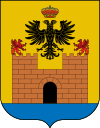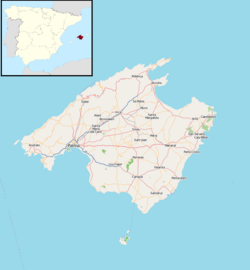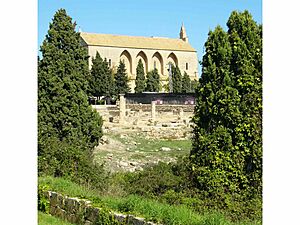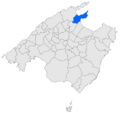Alcúdia facts for kids
Quick facts for kids
Alcúdia
|
||
|---|---|---|

Gate of the city walls
|
||
|
||

Map of Alcúdia in Mallorca
|
||
| Country | Spain | |
| Autonomous community | Balearic Islands | |
| Insular council | Mallorca | |
| Comarca | Raiguer | |
| Judicial district | Inca | |
| Area | ||
| • Total | 60.05 km2 (23.19 sq mi) | |
| Elevation | 13 m (43 ft) | |
| Population
(2018)
|
||
| • Total | 19,793 | |
| • Density | 329.61/km2 (853.68/sq mi) | |
| Time zone | UTC+1 (CET) | |
| • Summer (DST) | UTC+2 (CEST) | |
| Postal code |
07400
|
|
Alcúdia is a town and municipality (a type of local government area) in the Balearic Islands of Spain. It is a major tourist spot in the northern part of Majorca. Many hotels are found in Port d'Alcúdia and Platja d'Alcúdia. These areas are along a long beach that stretches for about 14 kilometers (9 miles). Alcúdia's old town is very well kept. It has buildings from the 13th century and is surrounded by an old medieval wall.
Contents
History of Alcúdia
The area where Alcúdia is located has been lived in since the Bronze Age. But its story really begins when the Romans arrived. The Romans used Alcúdia's beaches when they took over the island in 123 BC.
The Roman City of Pollentia
Soon after, the Roman capital Palma was founded. Then, the city of Pollentia was built. From Pollentia, people could see both the bay of Pollença and the bay of Alcúdia. Pollentia helped protect the island from invaders.
After the Roman Empire became weaker, pirates attacked Pollentia many times. The city was also attacked by the Vandals. Eventually, people left Pollentia. They moved to a safer place and started a new town called Pollença. The old Roman city of Pollentia was left in ruins.
Alcúdia's Founding and Growth
The name Alcúdia comes from the Arabic word "al-kudja," meaning "on the hill." This refers to a Moorish farm that was built near the old Pollentia site. In 1229, King James I of Aragon attacked the Moors and took control of the area.
In 1298, King James II of Aragon bought the Alcúdia farm. He then founded the new town of Alcúdia. A church, a graveyard, and a town square were built that same year. The construction of the town walls also began then and finished in 1362. The way the city was planned back then is still how Alcúdia looks today. Later, during the Renaissance, the walls were rebuilt.
Challenges and Revival
During the 16th century, pirates attacked Alcúdia many times. Some people left the town. In 1779, a decision was made to build a harbor to help the town. This really improved Alcúdia's economy and helped save the village. However, it stayed a rather small town for a while.
Alcúdia Today
In the 1920s, a few tourists started visiting Majorca and Alcúdia. But it was on a very small scale. The town's economy remained weak. In the early 1970s, it became clear that tourism would be Alcúdia's future.
Tourism Boom
About 15 years later, the old harbor of Puerto de Alcúdia had become a big resort for European tourists. In the 1990s, the building boom slowed down. New rules were put in place to make sure the resort stayed high quality. The old town has been kept in good condition. It is now a pedestrian area, meaning cars are not allowed. It has become one of the most visited towns in Majorca.
The Port of Alcudia is a small port. It mainly handles passenger ferries.
Main Sights and Activities
Alcúdia has many interesting places to see and things to do.
Historic Sites
- Old Town Walls: The old town has a wall from the 14th century. You can walk on top of the wall and go almost all the way around the village.
- Roman Ruins: Just outside the medieval town walls, near the Church of St. Jaume, you can see the remains of the ancient Roman city of Pollentia. There is also a small Roman theater.
- Bullring: North of the town, there is a bullring that was built in the 19th century.
Markets and Food
The old town hosts a market every Sunday and Tuesday all year. Inside the walls, you will find many restaurants and bistros. In Port d'Alcúdia, most restaurants are located around the marina. Many of these are open mainly during the tourist season.
Beaches and Nature
Further north and west, there are lovely coves and beaches. These are perfect for sunbathing, swimming, or snorkeling. One such spot faces the small island of S'Illot. Alcúdia's main beach is about 14 kilometers (9 miles) long. It stretches all the way to Ca'n Picafort. Alcúdia is also next to Playa de Muro, which is home to S'Albufera. This is a natural park that is very popular for birders.
Festivals and Events
Alcúdia celebrates the festival of St. Jaume every summer. It lasts for nine days in early July. Before the festival, the town is decorated. Each street chooses a theme for its decorations. During the festival, there are many traditional evening parties in the old town. One is the Night of the Romans, where locals dress in old Roman clothes. There are also outdoor plays, sports games, and exhibitions. The festival ends with a fireworks show and a concert by the old walls.
Alcúdia also has many other fairs and festivals throughout the year. In summer, there are outdoor events. These include tours of the old town with actors and plays in the old Roman amphitheater. The Alcúdia Jazz Festival starts in late August and lasts a month. International sports events are held at the port. These include an Ironman Triathlon twice a year, beach volleyball, and beach rugby. There is an agricultural fair in early October and a nautical fair in April.
Every three years, the Triennial of Sant Crist takes place. This is a religious procession where people walk barefoot through the town in silence for hours. This tradition started in 1507. People believe that an image of Sant Crist sweated blood and water, which ended a drought.
Sports
Alcúdia is home to the football club UD Alcúdia. They play at Estadi Municipal Els Arcs, which can hold 1,750 people.
Images for kids
See also
 In Spanish: Alcudia para niños
In Spanish: Alcudia para niños











